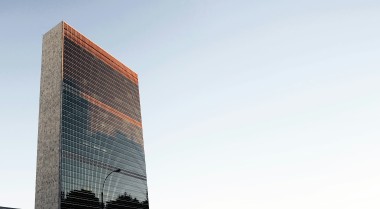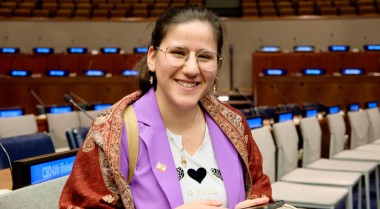The 2025 PBAR Informal Phase is over: What are the concrete, actionable recommendations for change?
The informal phase of the 2025 Peacebuilding Architecture Review (2025 PBAR) concluded with the 8 May 2025 Informal Interactive Dialogue among Member States. The next step for the co-facilitators - Egypt and Slovenia - is to present a zero draft of the outcome document based on the input collected during the informal phase.
During the Dialogue, Member States shared an expectation that the 2025 PBAR process leads to meaningful adjustments towards improved efficiency and impact of the UN Peacebuilding Architecture (PBA), making it ‘fit for purpose’.
But how Member States envision a PBA that fits for purpose? And what practical shifts need to be accomplished?
This blog attempts to summarise the Informal Interactive Dialogue (the Dialogue), highlighting the key points of consensus and alignment among Member States and concrete action points proposed. We also attempt to complement areas that Member States left vague with recommendations from the informal multi-stakeholder process held in 2024.
The UN Peacebuilding Architecture that ‘fits for purpose’ focuses on its impact at the field level, including on the lives of people living within communities.
The focus on impact is not new, as it is the goal of the 2025 PBAR from the outset. During the Dialogue, it was clear the Member States wanted a positive change at the field level; however, what peacebuilding has to change remains unclear. One concrete proposal was to measure impact in terms of change in trust, inclusion and resilience at the field level. This is in line with findings from a consultation organised by the Netherlands during the informal phase. Several Member States reiterated that impact should be defined by national and local actors. The documentation of impact is important for two reasons: 1) to sustain and expand donor interest in funding peacebuilding and 2) genuinely transition towards more effective peacebuilding approaches. Both the Peacebuilding Impact Hub and Peacebuilding Commission have a role to play.
>>> The resolution on peacebuilding and sustaining peace should encourage Member States to strengthen the capacity of the Peacebuilding Impact Hub to become a publicly accessible and inclusive platform that serves to promote evidence-based approach to peacebuilding and sustaining peace.
>>> The resolution on peacebuilding and sustaining peace should invite the Peacebuilding Commission to leverage its convening capacity to amplify and unpack the impact of peacebuilding action, especially when focusing on specific countries.
The UN Peacebuilding Architecture that ‘fits for purpose’ supports inclusive national responsibility to build peace and prevent conflict.
Most Member States referred to a complex issue of national ownership. It is already agreed that the responsibilities of national governments include ‘identifying, driving and directing priorities, strategies and activities for sustaining peace’, based on the principles of ‘inclusivity [...] to ensure that the needs of all segments of society are taken into account’ (A/RES/70/262-S/RES/ 2282, PP9). It is essential to unpack these responsibilities further because peacebuilding action often fails due to the lack of political will on part of the governments. During the Dialogue, some Member States contested inclusivity in national ownership, specifying that the decision-making is on the national government. On the other hand, some focused the discussion on national ‘responsibility’ for building sustaining peace through identifying priorities and creating an enabling environment for action. There seems to be little movement on the willingness of Member States to articulate what national ownership entails.
>>> The resolution on peacebuilding and sustaining peace should request Member States to 1) identify a government entity specifically tasked with peacebuilding and sustaining peace; 2) promote the engagement of local governments; 3) increase mobilisation of domestic resources for peace; and 4) establish inclusive consultative processes for the development of national prevention and peacebuilding strategies.
The UN Peacebuilding Architecture that ‘fits for purpose’ prioritises strengthening of the Peacebuilding Commission.
Following up on the Pact for the Future’s commitment to strengthen the Peacebuilding Commission, Member States articulated several ways in which the Commission can serve them. First, the Commission can act as a knowledge hub to exchange good practices, promote the development of tools to address new risks (i.e, climate change), inspire data-driven approaches, and share inclusive conflict analysis and strategic foresight. Second, the Commission can provide substantive and technical and political support in the development of national prevention strategies and for countries in transition. Country-specific configurations could be a modality for consistent support and ongoing follow-up to build on. The engagement of the Commission in the Gambia is another inspiration for action. Third, the Commission could enhance efforts to bring diverse actors together, providing diverse expertise to be available to the Commission and its members. Fourth, the Commission could track resource mobilisation efforts as a way to map out concrete gaps and financial needs, making a clearer case for donors to invest in. However, the question is whether the Commission is able to fulfill all of these roles, and what needs to be in place for the Commission to do that?
>>> The resolution on peacebuilding and sustaining peace should encourage efforts to improve visibility of the Commission, including through collaboration with the Department of Global Communications and the UN field presences.
>>> The resolution on peacebuilding and sustaining peace should call upon Member States to strengthen capacity for the Commission Secretariat to support increased demand, including the institutional support for quality advice to other intergovernmental bodies, monitoring of impact and follow-up of the Commission’s work at the field level.
>>> The resolution on peacebuilding and sustaining peace should establish a Commission’s Bureau for civil society engagement to ensure a systematic and transparent mechanism for selecting civil society briefers and provide diverse technical expertise to the Commission upon its request.
>>> The resolution on peacebuilding and sustaining peace should invite the Commission to offer an observer status to the recipient countries and regional organisations, particularly those in conflict-affected contexts.
>>> The resolution on peacebuilding and sustaining peace should designate a particular chamber for the Commission and invite the Secretary-General to ensure that the Commission’s work is supported by adequate resources.
>>> The resolution on peacebuilding and sustaining peace should invite the Commission to consider a reform of its working methods in line with the findings of the 2025 PBAR, provide for a predictable schedule, and revise the application of the consensus principle, specifically in the Commission’s advice.
The UN Peacebuilding Architecture that ‘fits for purpose’ mobilises flexible, long-term financing aligned with inclusive national priorities.
Member States reiterated the need for ‘adequate, predictable and sustained’ financing for peacebuilding. This language is not new. Many Member States, primarily from the Global South, suggested a different standard: the one rooted in flexibility, long-term availability and alignment with inclusive national priorities. They highlighted that peacebuilding is not a project and should not be treated as such.
>>> The resolution on peacebuilding and sustaining peace should call upon the donor community to ensure financing for peacebuilding that is flexible, long-term financing aligned with inclusive national priorities.
A lot of practical recommendations, including on the donor coordination modalities and the engagement with international financial institutions, regional development banks and the private sector, were already reflected in the 2022 General Assembly resolution on financing for peacebuilding (A/RES/76/305).
>>> The resolution on peacebuilding and sustaining peace should invite Member States to review the implementation of the 2022 General Assembly Resolution on financing for peacebuilding.
Many Member States highlighted the fact that the Peacebuilding Fund needs to be well-resourced. Even with resolutions A/RES/76/305 and A/RES/78/257 (2024), the Fund cannot manage growing demand. Some Member States highlighted that the Fund should increase its dedicated funding for transitions and better link with the Commission on this. However, no concrete proposals were made to increase the influx of financial resources into the Fund. Some Member States highlighted the need to improve accountability of the Fund and provide an opportunity to recipient countries to share their experiences through the Commission discussions.
>>> The resolution on peacebuilding and sustaining peace should invite the Commission to have a standing agenda item to receive regular updates on the Fund’s allocations and their impact.
The UN Peacebuilding Architecture that ‘fits for purpose’ optimises coordination on peacebuilding within the UN System.
Member States requested increased coordination between the Commission and other intergovernmental bodies, including the UN Security Council (UNSC), General Assembly, ECOSOC and, according to some, Human Rights Council (HRC). The role of the Commission is central for advancing the Triple Nexus, as risks that the Commission should be fit to address refer to all three pillars of the UN System. At the same time, many Member States urged complementarity based on respective mandates.
>>> The resolution on peacebuilding and sustaining peace should invite all intergovernmental bodies to organise more regular and structured dialogues among Presidents and wider membership of these bodies, with the modality of this Informal Interactive Dialogue being a good practice example to continue.
The relationships between the Council and the Commission expectedly gained a lot of attention. Member States recommended more regular and structured interactions between the Commission and the Council, including more briefings by the Commission’s Chair. The Council was also invited to more regularly request the Commission’s advice in a timely manner, especially on countries in transition. For the advice to be strengthened, members of the Commission should not prevent the attempts to reinvision the format of the advice and allow the practice to evolve. The inclusion of diverse stakeholders’ perspectives in the advice could help increase its effectiveness.
>>> The resolution on peacebuilding and sustaining peace should invite the Commission to provide more strategic political advice to the Council and encourage the Council to request such advise more often, with a follow-up reporting back to the Commission about the ways in which the advise was or was not used.
>>> The resolution on peacebuilding and sustaining peace should invite more regular and structured engagement of the Commission’s Chair in Council’s formal and informal meetings, especially on the countries in transition.
One of the main developments in the Dialogue was increased recognition by Member States that the UN Development System plays an important role in peacebuilding and sustaining peace. The PBA currently does not have field presences, aside from a few PBF’s in-country secretariats. This significantly challenges the opportunities for the PBA to make impact at the field level. As stated by one of the co-facilitators, the entire UN System must embrace peacebuilding. Member States recognised that Resident Coordinators (RCs) can support governments in the development of national peacebuilding and prevention strategies. The position of peace and development advisors (PDAs) are further critical to proper peacebuilding capacities within the RC Offices and Country Teams (UNCTs). Further, the RCs should improve its communication with the Commission, including by meeting with the Commission during the annual RC retreat.
>>> The resolution on peacebuilding and sustaining peace should encourage more frequent engagement between the Commission and RCs and invite PBSO, in collaboration with DCO, to facilitate follow-ups after PBC meetings in which RCs are briefers.
Member States highlighted a need for a more consistent and integrated peacebuilding orientation within UN peace operations and peacekeeping missions, particularly regarding planning, financing, and the involvement of the Commission itself. The upcoming review of peace operations and the Ministerial Meeting on Peacekeeping were considered as opportunities for finding synergies, if the PBA is more involved in these processes.
>>> The resolution on peacebuilding and sustaining peace should encourage the Council to include peacebuilding considerations across the life of peacekeeping missions and peace operations.
>>> The resolution on peacebuilding and sustaining peace should request unspent peacekeeping budgets to be spent on peacebuilding action.
What’s next? Towards a new resolution on peacebuilding and sustaining peace
A zero draft of the resolution will be launched very soon. Member States now face the challenging task of balancing their political priorities with the technical knowledge gathered throughout the 2024–2025 period.
What’s important to keep in mind is that the focus is on the “how.” As stated during the Dialogue, there is no need to redefine the system — the priority is to make better use of the existing multilateral framework in ways that make a difference for people’s lives.


